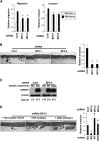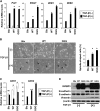Insulin-like growth factor-binding protein-3 promotes transforming growth factor-{beta}1-mediated epithelial-to-mesenchymal transition and motility in transformed human esophageal cells
- PMID: 20513670
- PMCID: PMC2915630
- DOI: 10.1093/carcin/bgq108
Insulin-like growth factor-binding protein-3 promotes transforming growth factor-{beta}1-mediated epithelial-to-mesenchymal transition and motility in transformed human esophageal cells
Abstract
Insulin-like growth factor-binding protein (IGFBP)-3 is overexpressed frequently in esophageal squamous cell carcinoma. Yet, the role of IGFBP3 in esophageal tumor biology remains to be elucidated. We find that IGFBP3 facilitates transforming growth factor (TGF)-beta1-mediated epithelial-to-mesenchymal transition (EMT) in transformed human esophageal epithelial cells, EPC2-hTERT-EGFR-p53(R175H). In organotypic 3D culture, a form of human tissue engineering, laser-capture microdissection revealed concurrent upregulation of TGF-beta target genes, IGFBP3 and EMT-related genes in the cells invading into the stromal compartment. IGFBP3 enhanced TGF-beta1-mediated EMT as well as transcription factors essential in EMT by allowing persistent SMAD2 and SMAD3 phosphorylation. TGF-beta1-mediated EMT and cell invasion were enhanced by ectopically expressed IGFBP3 and suppressed by RNA interference directed against IGFBP3. The IGFBP3 knockdown effect was rescued by IGFBP3(I56G/L80G/L81G), a mutant IGFBP3 lacking an insulin-like growth factor (IGF)-binding capacity. Thus, IGFBP3 can regulate TGF-beta1-mediated EMT and cell invasion in an IGF or insulin-like growth factor 1 receptor-independent manner. IGFBP3(I56G/L80G/L81G) also promoted EMT in vivo in a Ras-transformed human esophageal cell line T-TeRas upon xenograft transplantation in nude mice. In aggregate, IGFBP3 may have a novel IGF-binding independent biological function in regulation of TGF-beta1-mediated EMT and cell invasion.
Figures






Similar articles
-
In vivo and in vitro evidence for transforming growth factor-beta1-mediated epithelial to mesenchymal transition in esophageal adenocarcinoma.Cancer Res. 2006 Oct 1;66(19):9583-90. doi: 10.1158/0008-5472.CAN-06-1842. Cancer Res. 2006. PMID: 17018615
-
EGF-mediated regulation of IGFBP-3 determines esophageal epithelial cellular response to IGF-I.Am J Physiol Gastrointest Liver Physiol. 2006 Feb;290(2):G404-16. doi: 10.1152/ajpgi.00344.2005. Epub 2005 Oct 6. Am J Physiol Gastrointest Liver Physiol. 2006. PMID: 16210470 Free PMC article.
-
[Transforming growth factor beta1 regulation of epithelial-mesenchymal transition in esophagus squamous cell carcinoma].Zhonghua Bing Li Xue Za Zhi. 2008 Aug;37(8):542-8. Zhonghua Bing Li Xue Za Zhi. 2008. PMID: 19094466 Chinese.
-
Regulation of extracellular matrix remodeling following transforming growth factor-beta1/epidermal growth factor-stimulated epithelial-mesenchymal transition in human premalignant keratinocytes.Cells Tissues Organs. 2007;185(1-3):116-22. doi: 10.1159/000101312. Cells Tissues Organs. 2007. PMID: 17587817 Review.
-
Complexity in interpretation of embryonic epithelial-mesenchymal transition in response to transforming growth factor-beta signaling.Cells Tissues Organs. 2007;185(1-3):131-45. doi: 10.1159/000101314. Cells Tissues Organs. 2007. PMID: 17587819 Free PMC article. Review.
Cited by
-
Insulin-like growth factor binding protein 3 promotes radiosensitivity of oral squamous cell carcinoma cells via positive feedback on NF-κB/IL-6/ROS signaling.J Exp Clin Cancer Res. 2021 Mar 13;40(1):95. doi: 10.1186/s13046-021-01898-7. J Exp Clin Cancer Res. 2021. PMID: 33712045 Free PMC article.
-
The metastasis-promoting roles of tumor-associated immune cells.J Mol Med (Berl). 2013 Apr;91(4):411-29. doi: 10.1007/s00109-013-1021-5. Epub 2013 Mar 21. J Mol Med (Berl). 2013. PMID: 23515621 Free PMC article. Review.
-
TGF-β-induced IGFBP-3 is a key paracrine factor from activated pericytes that promotes colorectal cancer cell migration and invasion.Mol Oncol. 2020 Oct;14(10):2609-2628. doi: 10.1002/1878-0261.12779. Epub 2020 Sep 1. Mol Oncol. 2020. PMID: 32767843 Free PMC article.
-
Overexpression of IGFBP3 is associated with poor prognosis and tumor metastasis in nasopharyngeal carcinoma.Tumour Biol. 2016 Nov;37(11):15043-15052. doi: 10.1007/s13277-016-5400-8. Epub 2016 Sep 22. Tumour Biol. 2016. PMID: 27658775
-
Molecular mechanism underlying epithelial-mesenchymal transformation and cisplatin resistance in esophageal squamous cell carcinoma.Thorac Cancer. 2023 Nov;14(31):3069-3079. doi: 10.1111/1759-7714.15094. Epub 2023 Sep 17. Thorac Cancer. 2023. PMID: 37718469 Free PMC article. Review.
References
-
- Enzinger PC, et al. Esophageal cancer. N. Engl. J. Med. 2003;349:2241–2252. - PubMed
-
- Nakagawa H, et al. Biology of esophageal cancer. In: Rustgi AK, editor. Gastrointestinal Cancers. London: Elsevier; 2003. pp. 241–251.
-
- Itakura Y, et al. Epidermal growth factor receptor overexpression in esophageal carcinoma. An immunohistochemical study correlated with clinicopathologic findings and DNA amplification. Cancer. 1994;74:795–804. - PubMed
-
- Parenti AR, et al. p53 overexpression in the multistep process of esophageal carcinogenesis. Am. J. Surg. Pathol. 1995;19:1418–1422. - PubMed
Publication types
MeSH terms
Substances
Grants and funding
LinkOut - more resources
Full Text Sources
Research Materials
Miscellaneous

